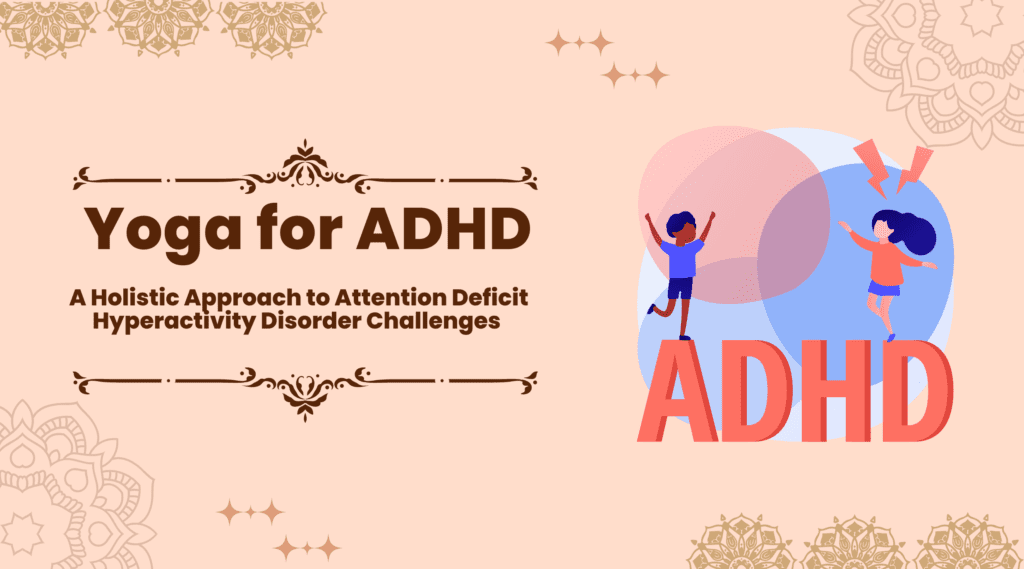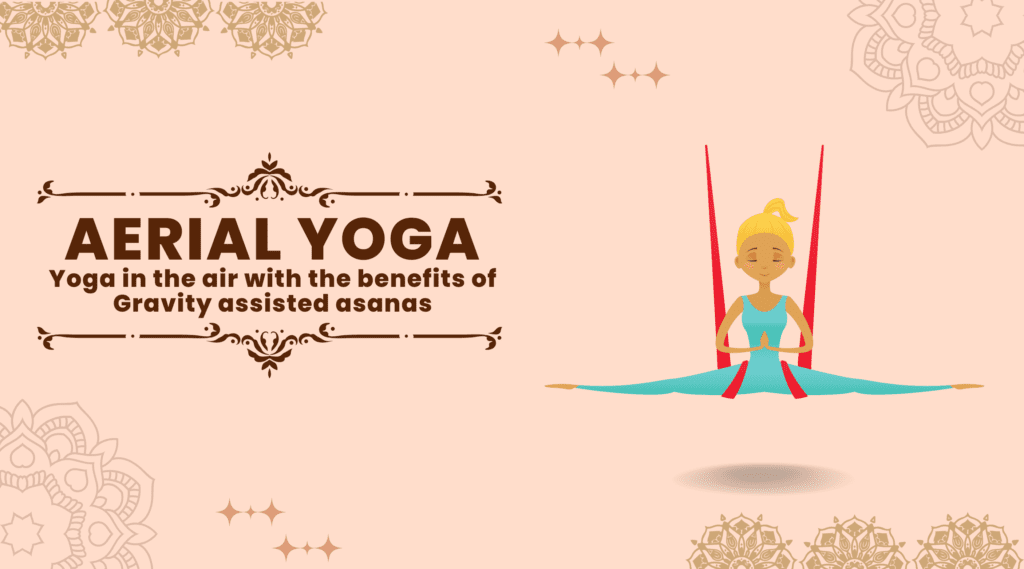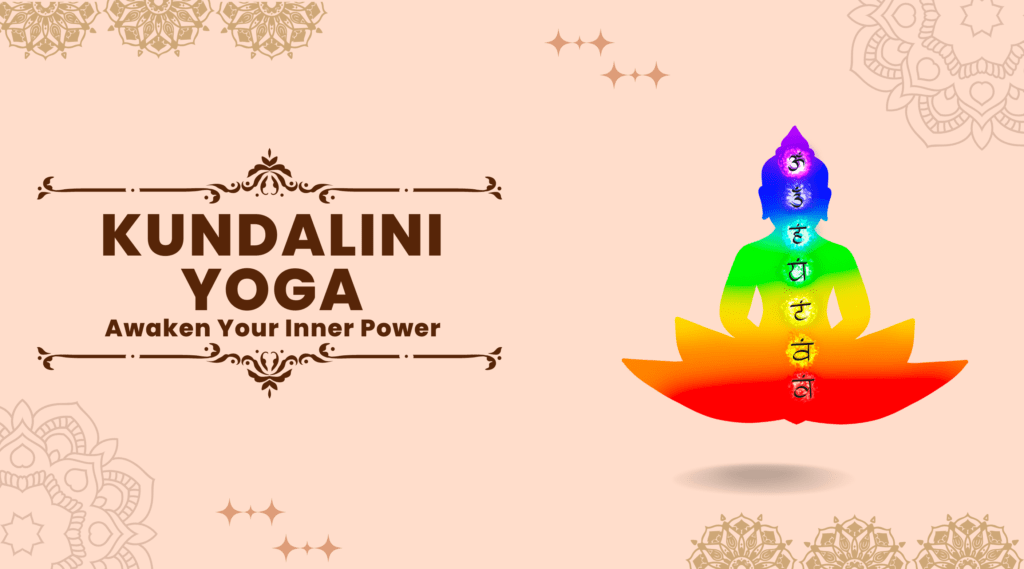Yoga for Attention Deficit Hyperactivity Disorder: A Holistic Approach to ADHD Challenges

Introduction
What is Attention Deficit Hyperactivity Disorder?
Attention Deficit Hyperactivity Disorder or ADHD is a kind of neurodevelopmental disorder. This disorder generally begins in childhood and can persist into adulthood. People with ADHD often experience difficulties with attention, impulse control and hyperactivity.
Treatment for ADHD often involves a multimodal approach that combines behavioural interventions, psycho education and in some cases medication.
Behavioural interventions may include strategies to improve organisational skills, time management as well as behaviour modification techniques. Medications such as stimulants (e.g. methylphenidate) or non-stimulants (e.g. atomoxetine) helps manage symptoms in many cases.
Apart from that there is one more option for managing ADHD, that is Yoga for Attention Deficit Hyperactivity Disorder. We will discuss later in this article how yoga can help in ADHD.
Suggested: Best Yoga Retreats And Yoga Teacher Training In Rishikesh
History of Attention Deficit Hyperactivity Disorder
The history of ADHD dates back to the early 20th century. Though the disorder was not officially recognized until later years, However, here are some milestones in the history of ADHD:
1902:
British paediatrician Sir George Still delivered a series of lectures in which he described a group of children who displayed symptoms of inattention, hyperactivity, and impulsivity. He referred to these children as having a “defect of moral control.”
1937:
American physician Charles Bradley conducted studies using stimulant medication (Benzedrine) to treat children with behavioural and attention difficulties. He observed improvements in their behaviour and attention, laying the foundation for future ADHD treatments.
1960:
The term “hyperkinetic impulse disorder” emerged, describing children with significant hyperactivity and impulsivity. This term later evolved into “hyperactivity” and “hyperactive child syndrome.”
1980:
The Diagnostic and Statistical Manual of Mental Disorders (DSM-III) included the diagnosis of Attention Deficit Disorder with or without hyperactivity (ADD/ADHD) for the first time, recognizing it as a legitimate psychiatric disorder.
1987:
The DSM-III-R revised the diagnostic criteria and introduced the term “Attention-Deficit Hyperactivity Disorder” (ADHD) to encompass both the hyperactive-impulsive and inattentive symptoms.
1994:
The DSM-IV provided further refinements to the diagnostic criteria for ADHD and introduced subtypes: predominantly inattentive, predominantly hyperactive-impulsive, and combined.
2013:
The DSM-5 was published, merging the subtypes into a single diagnosis of ADHD with specifiers to indicate symptom presentation (e.g., predominantly inattentive presentation, predominantly hyperactive/impulsive presentation, combined presentation).
Throughout the years, research on ADHD has expanded, shedding light on its neurological underpinnings, genetic factors, and environmental influences. The understanding of ADHD has evolved from a view that attributed it solely to environmental causes (such as poor parenting) to recognizing the complex interplay between genetics, brain functioning, and environmental factors.
Today, ADHD is a well-recognized neurodevelopmental disorder, and numerous interventions and treatments are available to support individuals with ADHD in managing their symptoms and improving their daily functioning.
Types of Attention Deficit Hyperactivity Disorder
There are three main types of ADHD, which are based on the predominant symptoms present in an individual. These types are defined in the Diagnostic and Statistical Manual of Mental Disorders (DSM-5), a widely used diagnostic manual in the field of mental health.
The three types of ADHD are as follows:
Predominantly Inattentive Presentation: This type used to be known as Attention-Deficit Disorder (ADD). Individuals with predominantly inattentive presentation of ADHD have significant difficulties with attention and focus.
They may have trouble sustaining attention, following instructions, organising tasks, and may appear forgetful or easily distracted. Hyperactivity and impulsivity are less pronounced or not present.
Predominantly Hyperactive-Impulsive Presentation: This type is characterised by significant hyperactivity and impulsivity. Individuals with this presentation have difficulty sitting still, are constantly on the go, may interrupt or talk excessively, and have difficulty waiting their turn. Inattention symptoms are less pronounced or not present.
Combined Presentation: This is the most common type of ADHD. It involves a combination of significant inattention, hyperactivity, and impulsivity. Individuals with the combined presentation experience symptoms from both the predominantly inattentive and predominantly hyperactive-impulsive types.
Causes of ADHD
The exact causes of Attention Deficit Hyperactivity Disorder are not fully understood. ADHD is a complex and multi factorial disorder with both genetic and environmental factors playing a role.
Here are some factors that are supposed to develop ADHD:
Genetics: There is evidence to suggest that genetics plays a significant role in ADHD. Studies have shown that ADHD tends to run in families. Individuals with a close relative such as a parent or sibling with ADHD are at a higher risk of developing the disorder.
Specific genes related to dopamine regulation and brain development have been implicated in ADHD, although the genetic mechanisms are still being studied.
Brain Structure and Function: Research has shown that certain areas of the brain involved in attention, impulse control as well as executive functions may be different in individuals with ADHD.
There may be differences in the size, structure as well as activity levels of the prefrontal cortex, basal ganglia and other brain regions.
These differences can affect the regulation of neurotransmitters such as dopamine and norepinephrine, which are involved in attention and impulse control.
Neurotransmitter Imbalance: ADHD is associated with imbalances in certain neurotransmitters, particularly dopamine and norepinephrine.
These neurotransmitters play a role in regulating attention, motivation as well as impulse control. It is believed that abnormalities in the functioning of these neurotransmitters may contribute to the symptoms of ADHD.
Environmental Factors: Various environmental factors also work as potential contributors to ADHD although their precise influence is still being investigated.
Factors such as exposure to toxins (e.g., lead), prenatal tobacco smoke, alcohol or drug use during pregnancy, premature birth, low birth weight, and certain prenatal and early life experiences may increase the risk of developing ADHD.
However, it’s important to note that these factors are not definitive causes but rather potential influences.
Symptoms of ADHD
Symptoms of ADHD can vary in intensity and presentation from person to person and may change over time. The disorder involves persistent patterns of inattention, hyperactivity as well as impulsivity. Also, they are more frequent and severe than typically observed in individuals at a similar developmental stage.
Some individuals may also have additional conditions or co-existing disorders, such as learning disabilities, anxiety, or mood disorders, which can further complicate the clinical picture.
The symptoms for ADHD are generally grouped into two categories: inattentiveness and hyperactivity/impulsivity.
Here are some common symptoms associated with each category:
Inattentive Symptoms:
Difficulty sustaining attention: Having trouble staying focused on tasks, being easily distracted by external stimuli as well as frequently shifting attention from one activity to another.
Poor organisation and planning: Struggling with organising tasks, managing time effectively, and frequently losing or misplacing things needed for daily activities.
Forgetfulness: Frequently forgetting important details, such as appointments, deadlines, or instructions, and having difficulty following through on instructions or completing tasks.
Lack of attention to detail: Making careless mistakes in schoolwork, work tasks, or other activities, and having difficulty following instructions that require attention to detail.
Difficulty listening: Having trouble listening and paying attention during conversations, lectures, or lengthy discussions.
Hyperactivity/Impulsivity Symptoms:
Restlessness and fidgeting: Having difficulty staying seated, feeling restless or constantly on the go, and engaging in excessive physical movements like tapping feet or squirming.
Difficulty with quiet activities: Struggling to engage in quiet, leisurely activities, and feeling the need to engage in excessive physical or mental activity.
Excessive talking: Frequently interrupting others, talking excessively without considering turn-taking, and struggling to wait for their turn to speak.
Impulsivity: Acting on impulses without thinking through the consequences, such as blurting out answers, interrupting others, or engaging in risky behaviours without considering potential dangers.
Difficulty waiting: Having trouble waiting in line or waiting for turns in activities, leading to impatience and frustration.
Adult ADHD Symptom
ADHD can persist into adulthood, and while the core symptoms of ADHD remain consistent, they can manifest differently in adults compared to children. Bellow are some common adult ADHD symptoms:
1. Inattention:
Adults with ADHD may struggle with sustaining focus and attention, especially during tasks that are repetitive or require prolonged mental effort. They may have difficulty organising tasks, maintaining a structured routine, and frequently overlook important details.
2. Hyperactivity:
While hyperactivity may decrease in adulthood, it can still be present. Adults with ADHD may experience inner restlessness, feeling the need to be in constant motion or engaged in multiple activities simultaneously. They may have difficulty relaxing or engaging in quiet activities.
3. Impulsivity:
Impulsivity in adults with ADHD can manifest as impulsive decision-making, difficulty considering long-term consequences, as well as acting without fully thinking through the outcomes. This can lead to difficulties in managing finances, relationships, and personal responsibilities.
4. Time management and procrastination:
Adults with ADHD often struggle with time management, leading to challenges in meeting deadlines, prioritising tasks, and managing their schedules. Procrastination is a common issue, with tasks being delayed until the last moment, causing stress and impaired productivity.
5. Organisation and forgetfulness:
Difficulties with organisation and forgetfulness persist into adulthood. Adults with ADHD may struggle with maintaining an organised living or work environment, frequently misplace items, and have difficulty keeping track of appointments or commitments.
6. Impaired working memory:
Working memory refers to the ability to hold and manipulate information in the mind for brief periods. Adults with ADHD may experience challenges with working memory, leading to difficulties in following multi-step instructions, remembering and executing tasks in the correct order, and recalling information.
7. Emotional dysregulation:
Many adults with ADHD experience emotional dysregulation, which can include difficulty managing frustration, irritability, and mood swings. They may be more prone to experiencing intense emotions and have difficulty regulating their reactions in different situations.
ADHD Symptoms In Adult Women:
If we talk about adhd symptoms in adult women, generally the adhd symptoms are similar in men and women, but adhd symptoms in adult women can be slightly different such as:
1. Emotional Sensitivity: Adult women with ADHD may be more emotionally sensitive and reactive, experiencing intense emotions and mood swings. They may have difficulty regulating their emotions, leading to challenges in managing stress, frustration, or criticism.
2. Perfectionism and Low Self-Esteem: Many women with ADHD develop coping mechanisms such as perfectionism as a way to compensate for their challenges with attention and organisation. They may have a fear of failure and experience low self-esteem due to a history of underachievement or feeling overwhelmed.
3. Social Difficulties: Women with ADHD often struggle with social interactions, maintaining friendships, and interpreting social cues. They may feel socially anxious or have difficulty initiating or sustaining conversations, leading to a sense of social isolation.
ADHD Symptoms In Adult Men:
ADHD symptoms in adult men can exhibit similarities but some differences also as compared to women such as:
1. Poor Impulse Control: Generally men with ADHD may struggle with controlling their impulses, leading to difficulties in managing anger, frustration, or impulsivity in response to certain situations. They may have a tendency to react quickly without considering the consequences.
2. Emotional Regulation Issues: Some men with ADHD may experience challenges with emotional regulation, leading to difficulties in managing and expressing emotions. They may have mood swings, experience irritability, or have difficulty coping with stress.
3. Risk-Taking Behaviour: Men with ADHD may be more prone to engaging in risk-taking behaviours, such as impulsively driving at high speeds, participating in extreme sports, or seeking out novelty and stimulation.
Adhd symptoms in kids
ADHD symptoms in children generally manifest in various domains of their daily functioning. The symptoms can be categorised into two main categories: inattention and hyperactivity/impulsivity as we discussed earlier:
1. Inattention Symptoms:
- Difficulty sustaining attention: Children with ADHD may have trouble staying focused on tasks, becoming easily distracted by irrelevant stimuli, and frequently shifting from one activity to another.
- Careless mistakes: They may make careless mistakes in schoolwork, overlook details, and have difficulty organising their work.
- Difficulty following instructions: Children with ADHD may struggle to follow through on instructions, particularly multi-step instructions, and may seem forgetful or disorganised.
- Poor organisation: They may have difficulty organising tasks, belongings, and daily activities.
- Forgetfulness: Children with ADHD may frequently forget or lose items necessary for school or daily activities.
2. Hyperactivity/Impulsivity Symptoms:
- Restlessness: Children with ADHD often exhibit excessive restlessness, being unable to stay seated or engage in activities that require sustained focus.
- Excessive talking: They may frequently interrupt conversations, have difficulty taking turns, and tend to talk excessively.
- Difficulty waiting: Children with ADHD may struggle with waiting their turn in games, activities, or conversations, often displaying impatience.
- Impulsive behaviour: They may act without considering the consequences, have difficulty controlling impulses, and engage in risky or dangerous behaviours.
- Difficulty playing quietly: Children with ADHD may have difficulty engaging in quiet play or leisure activities, often being overly active or loud.
ADHD Diagnosis Criteria
The ADHD diagnosis criteria is a specific criteria outlined in the Diagnostic and Statistical Manual of Mental Disorders (DSM-5). To For the diagnosys ofADHD, an individual must exhibit a persistent pattern of symptoms that are more frequent and severe than what is typically observed in individuals at a similar developmental stage.
The DSM-5 criteria for diagnosing ADHD include the following:
1. Symptoms of Inattention:
The individual must display at least six symptoms of inattention. These symptoms should be present for at least six months, be inconsistent with their developmental level, and significantly interfere with their functioning in at least two settings (e.g., home, school, work). Examples of inattention symptoms include:
- Often fails to give close attention to details or makes careless mistakes.
- Often has difficulty sustaining attention in tasks or play activities.
- Often does not seem to listen when spoken to directly.
- Often has difficulty organising tasks and activities.
- Often avoids, dislikes, or is reluctant to engage in tasks that require sustained mental effort.
- Often loses things necessary for tasks or activities.
- Often easily distracted by external stimuli.
- Often forgetful in daily activities.
2. Symptoms of Hyperactivity/Impulsivity:
The individual must display at least six symptoms of hyperactivity/impulsivity. These symptoms should be present for at least six months, be inconsistent with their developmental level, and significantly interfere with their functioning in at least two settings. Examples of hyperactivity/impulsivity symptoms include:
- Often fidgets with or taps hands or feet or squirms in their seat.
- Often leaves a seat in situations where remaining seated is expected.
- Often runs or climbs excessively when it is not appropriate.
- Often has difficulty playing or engaging in leisure activities quietly.
- Often talks excessively.
- Often blurts out answers before the question has been completed.
- Often has difficulty waiting for their turn.
- Often interrupts or intrudes on others.
3. Age of Onset:
Some symptoms of ADHD must be present before the age of 12 years.
4. Impairment and Impact:
The symptoms must be present in multiple settings (e.g., home, school, work) and cause clinically significant impairment in social, academic, or occupational functioning.
5. Exclusionary Criteria:
The symptoms should not be better explained by another mental disorder, such as a mood disorder, anxiety disorder, or pervasive developmental disorder.
How Yoga can help in ADHD
Yoga can be a beneficial approach to managing ADHD symptoms. While it may not be a standalone treatment, It can provide potential help in managing ADHD. Yoga can help in increasing mindfulness & focus, reducing stress, body awareness as well as self-regulation, which can be a great help in ADHD.
Yoga poses can be beneficial for individuals with ADHD by promoting relaxation, improving focus, and reducing hyperactivity. Here are some yoga poses that may be helpful:
1. Mountain Pose (Tadasana):
Stand tall with feet hip-width apart, grounding through the feet. Bring hands together in front of the chest. This pose promotes balance, stability as well as a sense of grounding.
2. Tree Pose (Vrksasana):
Stand with feet together, shift weight onto one leg while placing the sole of the other foot on the inner thigh or calf of the standing leg. Bring hands together in front of the chest. This pose enhances concentration and balance.
3. Warrior II (Virabhadrasana II):
Step feet wide apart, turn one foot out, bend the front knee as well as extend arms parallel to the floor. Gaze over the front fingertips. This pose builds strength, stability, and focus.
4. Downward Facing Dog (Adho Mukha Svanasana):
Begin on hands and knees, tuck toes, and lift hips up and back to form an inverted V shape. Press hands into the mat and keep heels reaching toward the ground. This pose stretches the body, releases tension, and helps calm the mind.
5. Child’s Pose (Balasana):
Kneel on the floor, sit back on the heels, and fold the torso forward while resting the forehead on the mat. Extend arms forward or alongside the body. This pose promotes relaxation, relieves stress, and encourages deep breathing.
6. Cat-Cow Pose (Marjaryasana-Bitilasana):
Begin on hands and knees. Inhale, arch the back, lift the chest, and gaze forward (Cow Pose). Exhale, round the back, tuck the chin toward the chest, and gaze toward the navel (Cat Pose). This flowing movement promotes spinal flexibility and can help release tension.
7. Corpse Pose (Savasana):
Lie flat on the back, arms by the sides while palms facing up. Close the eyes and relax the entire body. Focus on deep breathing and let go of any tension. This pose encourages deep relaxation while reducing anxiety and hyperactivity.
Pranayama and Meditation for ADHD
Apart from Yoga, Pranayama (breathing exercises) and meditation are valuable practices that can complement the management of ADHD symptoms. They promote relaxation, focus, and self-awareness.
Here are some pranayama and meditation techniques that may be beneficial for individuals with ADHD:
1. Deep Breathing:
Sit comfortably with an upright posture. Take slow, deep breaths while inhaling through the nose and exhaling through the mouth. Focus on the sensation of the breath as it enters and leaves the body. Deep breathing helps to calm the nervous system as well as reduce stress and anxiety.
2. Alternate Nostril Breathing (Nadi Shodhana):
Sit comfortably and use the thumb and ring finger of one hand to alternately close and open the nostrils. Inhale through one nostril, then exhale through the other nostril, and continue alternating. This technique helps balance energy, enhance focus, and promote a sense of calm.
3. Box Breathing:
Breathe in for a count of four, hold the breath for a count of four, exhale for a count of four, then hold the breath out for a count of four. Repeat this pattern several times. Box breathing can help regulate breathing, reduce stress and also improve mental clarity.
4. Mindfulness Meditation:
Find a comfortable seated position and focus attention on the present moment. Observe thoughts, sensations, and emotions without judgement, and gently redirect the focus back to the breath or a chosen point of focus whenever the mind wanders. Mindfulness meditation cultivates present-moment awareness, thus helps develop sustained attention and self-regulation.
5. Guided Visualisation:
Close the eyes and imagine a calm, peaceful scene or engage in a guided meditation that leads you through a visualisation exercise. This technique encourages relaxation, imaginative focus as well as can be helpful for reducing restlessness and improving attention.
6. Loving-Kindness Meditation:
Sit comfortably and silently repeat phrases of well-wishing and compassion for yourself and others. For example, you might repeat phrases like “May I be happy, may I be peaceful, may I be healthy” and extend those wishes to others. Loving-kindness meditation cultivates positive emotions, empathy, and connection.
Conclusion
Incorporating yoga into the management of Attention Deficit Hyperactivity Disorder can be a valuable complementary approach. Although it may not be a standalone treatment however however, yoga offers several potential benefits for individuals with ADHD.
By practising yoga, individuals can experience increased mindfulness, focus, relaxation as well as self-regulation. Yoga poses promote physical activity, balance, and body awareness. Therefore, it provides an outlet for excess energy and improving overall well-being.
Additionally, the structured nature of a yoga practice can create routine and stability in the lives of individuals with ADHD. Yoga’s emphasis on breath control, meditation, and relaxation techniques.
So, it helps reduce stress levels and enhance emotional regulation. However, it’s important to note that yoga should be used in conjunction with other evidence-based interventions such as medication, therapy and behavioural strategies, as part of a comprehensive treatment plan for ADHD.
Consulting with a healthcare professional while working with a qualified yoga instructor can ensure safe and effective integration of yoga practices into an individual’s Attention Deficit Hyperactivity Disorder management plan.
You Can Also Read:



